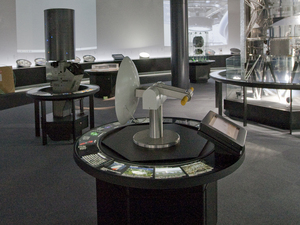Nagoya City Science Museum
TOP > Exhibition Guide > Keyword Search > Starting with "W" > world > Radio Astronomy
Radio Astronomy



Purpose of Exhibition
Radio astronomy is a field of astronomy that studies celestial objects by observing various wavelengths of radio emission from them.
This exhibit will show you the past observation results by radio waves and the photographs of antennas actually used for scientific researches all over the world; further, we will provide a hands-on experience where you can operate the parabolic antenna, discover radio sources hidden in the room and find out the states of them from the characteristics of their wavelength and waveform.
Additional Knowledge
What and how do radio waves tell us about the Universe?
[Discovery of Radio Waves from the Universe]
Radio waves from the Universe were first observed by an American radio engineer, Karl Jansky, in 1931. The technology developed for radar during World War II was applied to radio astronomy and consequently it opened “a new eye to the Universe.” Radio waves have longer wavelengths and are less easily scattered or absorbed by interstellar matter than shorter wavelengths such as visible light. So, radio waves can reveal secrets behind dark nebulae and allow us to see the Universe farther away. Radio observations have thus made significant discoveries: the galactic spiral structure, the 3K cosmic background radiation and pulsars.
[How does a Radio Telescope Work?]
Almost all radio telescopes have one or more parabolic dish antennas which have a curved, metallic surface with the cross-sectional shape of a parabola. Radio waves that strike the dish-like surface bounce up and converge at a single point above it, namely a focus.
The resolution of a telescope, or the ability to distinguish close objects finely, depends not only on the diameter of it, but also on the wavelength at which we observe. The larger the diameter, the higher the resolution; the longer the wavelength, the lower the resolving power. Radio waves have a much longer wavelength than visible light. So, the diameter of a radio telescope needs to be enormously large to get the same resolution as optical telescopes. Then, besides making large parabolic antennas, we also use the principles of interferometry; two or more antennas are placed thousands of kilometers apart, and work together as a single telescope to provide higher resolution.
[How and What Produces Radio Waves in the Universe?]
We know that radio emissions from celestial objects can be classified into various mechanisms. If you know which mechanism is dominant in a radio wave emission, you can determine the physical states of the radio source: temperature, matter density, motion, etc.
・Synchrotron Radiation
Synchrotron radiation is generated by electrons that are travelling at almost the speed of light. When Lorentz force alters their paths and they are spiraling through magnetic field, which is ubiquitous in the Universe, electrons emit the synchrotron radiation. So, by observing synchrotron emission, we can study objects with high temperatures and strong magnetic fields, such as galactic nuclei and supernova remnants.
・Thermal Bremsstrahlung
Thermal bremsstrahlung is emitted when electrons in a plasma are forced to bend their paths by the attraction of cations such as protons. The main source of this radiation is the gas region (HII region) ionized by the strong radiation of young OB stars.
・Recombination Lines
Recombination lines arise when electrons recombine with ionized atoms. Since electrons may only make transitions between specific energy levels of atoms or molecules, recombination lines are observed as line spectra specific to the atoms or molecules. Recombination lines in radio region are emitted from ionized gases at 10,000 to 100,000 degrees.
・21cm Line
The 21cm line, or hydrogen line, is a spectral line emitted in the spin-flip transition of neutral hydrogen atoms; Neutral atomic hydrogen clouds at 100 to 1,000 degrees Kelvin characteristically emit this 21cm line.
・Rotational Transition Lines
In gases below 100 degrees Kelvin, hydrogen or other atoms combine to form molecules. Molecules have specific rotational energy levels, and thus the transitions of their rotational states produce specific spectral lines. Such rotational transition lines are observed typically in dark nebulae, the molecular clouds, which are the sites of future star formation.
・Cosmic Microwave Background Radiation
The Cosmic Microwave Background radiation (CMB for short) is a remnant of the Big Bang. To be more precise, it is leftover glow of radiation that filled the Universe at 3,000 degrees Kelvin about 380,000 years after the Big Bang, which is the recombination epoch, or what we call “clear up of the Universe.” Since redshift increases the wavelength due to the universal expansion, we today observe the CMB as microwave radiation.
[ALMA]
ALMA (Atacama Large Millimeter/submillimeter Array) is a gigantic interferometer array with 66 parabola antennas located in the Atacama Desert, Chile. The ALMA project is conducted in international collaboration with Japan, Taiwan, the United States, Canada and ESO on behalf of the European Union. On March 13 2013, the ALMA observatory was inaugurated at an official ceremony.
ALMA is expected to greatly contribute the research of the Universe invisible to light: newborn galaxies 13 billion light-years away, the birth of planetary systems and organic molecules far beyond our Solar System.
This page was last edited on 15 June 2022.
Article by Astronomy Section
